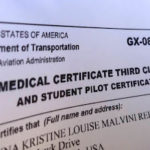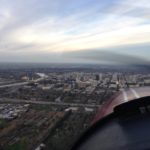Fly Girl in Training: The first taildragger lesson
| First surprise taildragger lesson in the Rans S-7S Courier. |
“We’re not flying the 182 today,” Stan said as he rolled up next to the hangar where I’d just finished my pre-flight inspection. In answer to my quizzical stare, my fearless flight instructor added, “We’re flying the Rans.”
The Rans. A taildragger with tandem seating which I’ve flown in once before and felt green to the gills. “Okay,” I replied, feeling grateful that I hadn’t yet pulled the Cessna 182 out of the hangar, all of a sudden bursting with nerves.
After a lengthy introduction to the airplane, where I noted the limited instructor controls in the back seat, I asked Stan to tell me about flying a taildragger. With a laugh he said, “It’s flies like any other airplane.”
Resisting the urge to punch his smart ass shoulder, I clarified. “How do you land a taildragger?”
Stan laughed again and gave me a brief overview of speed targets and how to use the rudders. But he quickly moved the show into the plane as landing a taildragger is not something that one can learn by talking, it’s a learn-by-doing activity.
And so I got my first taste of taildragger flying.
| I’m not ashamed to admit that 1.6 hours of taildragger time knocked me on my butt. A few hours later, I’m bone tired! |
I taxied to the run-up area, doing my best to make small rudder corrections and not lose control. A big issue with taildraggers is limited visibility due to the nose being up in the air and in your face (not a huge problem in the diminutive Rans S7, but significant in a larger beast like the Stearman or P-51).
Consequently, pilots must become proficient in S-turning while taxiing… slowly jogging back and forth, somewhat like a snake slithering, to keep an eye on the path ahead. All this while managing speed control, especially during turns. Taildraggers have a penchant for “ground looping” or spinning around as the center of gravity is behind the main wheels.
| Stan said to give him a “Rans smile” which I interpret as signature Shawna nose crinkles. |
Almost immediately I understood that time in the taildragger will help cure my “lazy feet” because rudder control is paramount in these types of aircraft. Tricycle geared planes like the 182 are infinitely more forgiving of poor rudder control and the “favorite” of yours truly: Not landing precisely on center line. The 182, for instance, is relatively stable and when set in a direction, will typically continue in that direction. A taildragger, on the other hand, wants to go in any and every direction, and it takes a ton of concentration and control to keep it going the way that you want.
During takeoff, I followed Stan on the controls, tap dancing on the rudders to keep the plane more or less in the center of the runway. During the climb, he told me to take over. While I practiced level flight, climbing/descending and coordinated turns, I felt clumsy and terrified and frankly, like I’d never flown before. Despite having 91 flight hours under my belt (30 being long cross-county to OSH), it was as if I was starting all over again. The control inputs felt different. Using a stick instead of a yoke didn’t exactly make sense at first. Trying to figure out how to gauge level flight without familiar instrumentation took effort.
| The best part about the Rans? What is typically worse in every other plane: The fuel bill! This plane burns something like 5 gallons per hour compared to my thirsty 13-gallons an hour 182. |
But nothing prepared me for trying to land the sucker.
We made our way to a nearby airfield, and Stan had me fly the pattern and then follow him on the controls for the landing. Although I ended up really liking the visibility and maneuverability of the Rans, it startled me how much action took place on landing–both with the stick and with our feet on the rudders.
The touch down–slow to me, in the this particular airplane–involved alternating the level of pressure on the rudder pedals constantly while at the same time manipulating the stick to land more or less on all three wheels.
| The guys next to me at the fuel pit burned up $451 in their Beech Baron. I win. |
If one were to “ground loop” when taking off or landing, the airplane could be damaged. So keeping things straight and under control is critical.
As I try to put this process into words, I understand Stan’s earlier point about learning-by-doing. Mr. T, a seasoned taildragger pilot, wished me luck in trying to describe it, saying the closest analogy he can offer is that landing and taxiing a taildragger is like running while trying to balance a broom on two fingers. It requires concentration and control of several different physical processes. In other words: It’s damn difficult.
Which is why I’m grateful to have this experience as a student pilot. If I can understand how to deal with wind and directional control in planes with a penchant for being wiley, I know I can be a better pilot in any aircraft I’m likely to fly.
xoxo,
shawna
Other flying posts:
- First time flying left seat
- Flight medical and student pilot certificate acquired!
- The four fundamentals, death grip not required
- Birthday av gas, wind corrections, and faux emergencies
- Getting the hang of landing the airplane
- Flying solo for the first time
- The ultimate cross-country- Flying to Oshkosh
- A student pilot landing at Oshkosh
- Formation flying: A photo montage and interview with my hot pilot husband
- Green gills and formation flying skills


